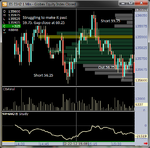robster970
Veteren member
- Messages
- 4,567
- Likes
- 1,390
Yesterday, I went off piste and did something 'dirty'. I averaged down on a trade. It was an intraday trade and the thought process went something like this. There is a screen shot to accompany what I did.
a) Yesterday opened in range on ES
b) Price struggled to make it past 59.75 area, the VPOC from Tuesday. T&S showed sellers coming in heavily here. Delta progressively -ve
c) Figure my trade opportunity is when 55.75 gets busted. This level has been held but I can see sellers overwhelming buyers generally on higher TF.
d) Go short at 56.25
e) Buyers show up, see some fight. It has immediately gone off side so I am anticipating bailing.
f) Gets to about 58 and I think to myself that today looks like it is mean reverting and am confident that gap will close (60.25) and turn
g) I hold until it gets to the gap close at 60.25 and wait a couple of minutes that it is running out of steam. I go short at 59.75. My average price moves up to 58. I have doubled my risk but am confident today is a mean reverting day due to the choppiness seen whilst the initial balance was forming.
h) It sells off again and I exit when it gets a bit sticky at 56.75
Was I just lucky there considering that it was fairly obvious that nobody wanted to trade above Tuesday's VPOC or would some consider averaging down in this kind of scenario a viable strategy? I am at pains to point out that the day was not an OTD or ORR or OD so felt comfortable that the 2-way auction creating the chop was setting up for a mean reverting kind of day.
The only point of hesitation I had was when it got to 58 and whether to half my risk back to normal. I chose not to.
Incidentally the 55.75 did get busted with a low at 53 with no extension past the gap close high of 60.25
a) Yesterday opened in range on ES
b) Price struggled to make it past 59.75 area, the VPOC from Tuesday. T&S showed sellers coming in heavily here. Delta progressively -ve
c) Figure my trade opportunity is when 55.75 gets busted. This level has been held but I can see sellers overwhelming buyers generally on higher TF.
d) Go short at 56.25
e) Buyers show up, see some fight. It has immediately gone off side so I am anticipating bailing.
f) Gets to about 58 and I think to myself that today looks like it is mean reverting and am confident that gap will close (60.25) and turn
g) I hold until it gets to the gap close at 60.25 and wait a couple of minutes that it is running out of steam. I go short at 59.75. My average price moves up to 58. I have doubled my risk but am confident today is a mean reverting day due to the choppiness seen whilst the initial balance was forming.
h) It sells off again and I exit when it gets a bit sticky at 56.75
Was I just lucky there considering that it was fairly obvious that nobody wanted to trade above Tuesday's VPOC or would some consider averaging down in this kind of scenario a viable strategy? I am at pains to point out that the day was not an OTD or ORR or OD so felt comfortable that the 2-way auction creating the chop was setting up for a mean reverting kind of day.
The only point of hesitation I had was when it got to 58 and whether to half my risk back to normal. I chose not to.
Incidentally the 55.75 did get busted with a low at 53 with no extension past the gap close high of 60.25


